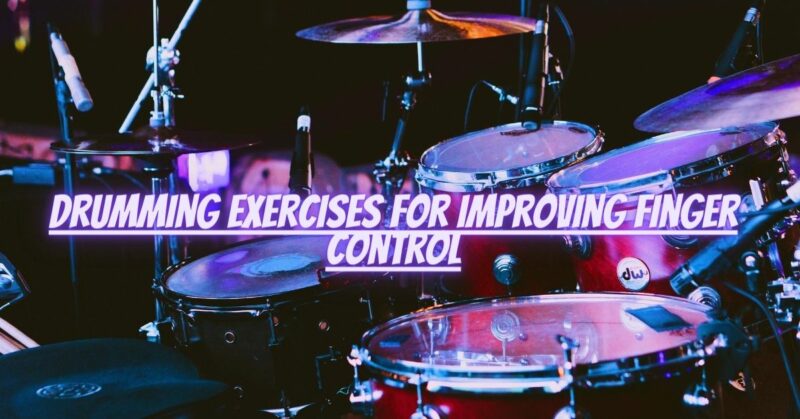Finger control is a vital skill for drummers, allowing for precise and articulate drumming techniques, such as rolls, flams, and intricate ghost notes. Developing finger control takes practice and exercises that focus on building strength, dexterity, and independence in your fingers. In this article, we will explore effective drumming exercises specifically designed to improve finger control, enabling you to enhance your drumming skills and add finesse and nuance to your playing.
- Finger Control Warm-Up: Begin with a finger control warm-up exercise to prepare your fingers for more challenging drills. Start by tapping your fingers individually on a practice pad or snare drum, focusing on producing even and controlled strokes. Begin with your index finger and gradually move through each finger, paying attention to maintaining consistent volume and timing. Repeat the exercise in reverse order, starting with your pinky finger. This exercise helps to awaken your finger muscles and promotes finger independence.
- Single Stroke Roll: The single stroke roll is a fundamental exercise for developing finger control. Start by playing alternating strokes between your hands at a comfortable tempo. Focus on using your fingers to control the rebound of the drumstick, maintaining a balanced and controlled sound. Gradually increase the speed while maintaining precision and evenness between each stroke. Practice this exercise with different dynamics to enhance control and finesse.
- Finger Control on Practice Pad: Using a practice pad, practice playing controlled strokes with your fingers only. Start by holding the drumstick near the fulcrum, allowing your fingers to control the movement and bounce of the stick. Begin with a slow tempo, playing single strokes and gradually increase the speed while maintaining control and consistency. Focus on the accuracy and precision of each stroke, using your fingers to articulate the sound.
- Finger Control Exercises with Accent Patterns: Incorporate accent patterns into your finger control exercises to further challenge your control and precision. Start with a simple accent pattern, such as playing accents on every fourth stroke within a continuous single stroke roll. Focus on producing clear and distinct accents while maintaining evenness and control on the non-accented strokes. Increase the complexity of the accent patterns as you progress, incorporating different accent placements and variations.
- Finger Control Rudiments: Practicing finger control within rudiments is an excellent way to improve dexterity and coordination. Focus on rudiments such as the single paradiddle, flam taps, and inverted flam taps. Start at a comfortable tempo and gradually increase the speed while maintaining control and accuracy. Pay attention to the quality and evenness of the strokes produced by your fingers.
- Finger Control with Offbeat Patterns: Developing finger control with offbeat patterns helps to improve coordination and independence. Practice playing offbeat patterns, such as offbeat eighth notes or offbeat sixteenth notes, while maintaining a steady pulse with your other hand. Use your fingers to articulate the offbeat notes precisely, ensuring clarity and consistency. Gradually increase the speed while maintaining control and accuracy.
- Finger Control and Dynamics: Working on finger control with varying dynamics is essential for expressive drumming. Practice playing the same patterns and exercises with different dynamics, ranging from soft to loud. Focus on maintaining control and consistency in both soft and loud strokes. Pay attention to the finesse and sensitivity of your finger control, ensuring that each stroke is controlled and deliberate.
- Finger Control Independence: Developing finger control independence involves playing different rhythms or patterns with each finger. Start with simple exercises, such as playing different rhythms or patterns between your index and middle finger, or middle and ring finger. Gradually increase the complexity by incorporating additional fingers. This exercise helps to improve finger independence and coordination.
Conclusion: Improving finger control is a gradual process that requires focused practice and patience. By incorporating these drumming exercises into your practice routine, you will enhance your finger control, dexterity, and independence. Start with a warm-up exercise to awaken your finger muscles, then progress to exercises focusing on single stroke rolls, finger control on practice pads, accent patterns, rudiments, offbeat patterns, dynamics, and finger control independence. Remember to maintain a relaxed and balanced technique, focusing on achieving controlled and precise strokes with your fingers. With consistent practice and dedication, you will develop the finger control necessary to execute rolls, flams, and intricate ghost notes with finesse and precision.


